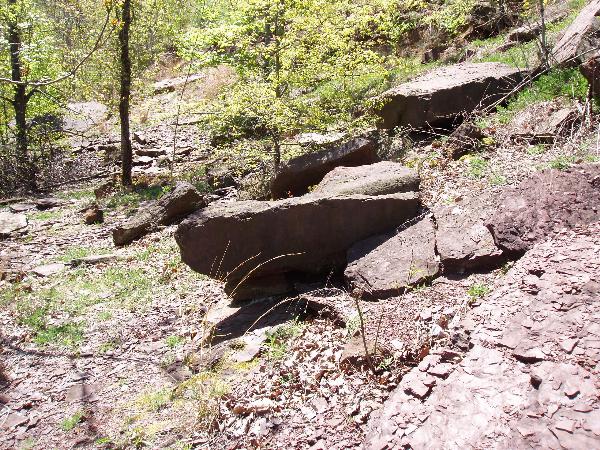
Riker Hill Quarry - Roseland, NJ
N 40° 48.945 W 074° 19.593
18T E 556795 N 4518522
This Waymark is located in Essex County, NJ., within the town of Roseland. There is a well-marked trail which leads to the geologic area. There is also some steep climbing involved as well.
Waymark Code: WM34RX
Location: New Jersey, United States
Date Posted: 02/10/2008
Views: 161
This site is also known as Roseland Quarry, Riker Hill Fossil Site, and Walter Kidde Dinosaur Park.

Background
This is a very interesting and unique area. First, it is not to be
found on any map. Second, one needs to walk through the woods for
about .14 miles until the actual trail is reached, which after a
short .12 mile walk quickly opens up into a dark red landscape of
rock. The uniqueness of this area is characterized by flaggy, fresh
exposures of sedimentary red beds. Once you reach ground zero,
there are large fields of flagstone strewn everywhere. About 200
feet further, there is a bonus feature, a high wall of basalt,
which is an igneous rock intrusion feature.
The red beds are from the Early Jurassic Towaco Formation,
consisting of layered shale and intervening flaggy sandstone that
preserve a variety of very well-preserved sedimentary structures
and some cool features including ripple marks, desiccation cracks
and occasionally, if you are lucky, trace fossils (rare dinosaur
tracks which are very tiny). It is illegal to remove anything,
especially fossils, from the area. Please look and handle gently
but do not destroy. At ground zero, there are a few fantastic areas
where you can see the layers of the shale on some larger rock
samples. FYI: There is a considerable amount of 3/4" Red Shale
which goes for about $79.00/yard at your local landscaper
commercial supply store.…don’t get any ideas!
How is sedimentary rock
formed?
For thousands, even millions of years, little pieces of earth have
been eroded and worn away by wind and water. These little bits of
earth are washed downstream where they settle to the bottom of
rivers, lakes, and oceans. Layer after layer of eroded earth is
deposited on top of each, pressed down more and more through time,
until the bottom layers slowly turn into rock. Shale rock is a type
of sedimentary rock formed from clay that is compacted together by
pressure. They are used to make bricks and other material that is
fired in a kiln. The small amounts of sandstone you may encounter
are also sedimentary rocks made from small grains of the minerals
quartz and feldspar. They often form in layers as seen in this
picture. They are often used as building stones.
 I did the following which helped me appreciate this area:
I did the following which helped me appreciate this area:
1. Stood under one of the outcrops to fathom the sheer mass of one of these and for an excellent photo-op.
2. Held a piece basalt and shale side by side & compared the two to better understand the differences
3. Climbed up the basalt wall to fully appreciate this site
4. Searched for dinosaur fossils BUT did not touch or take